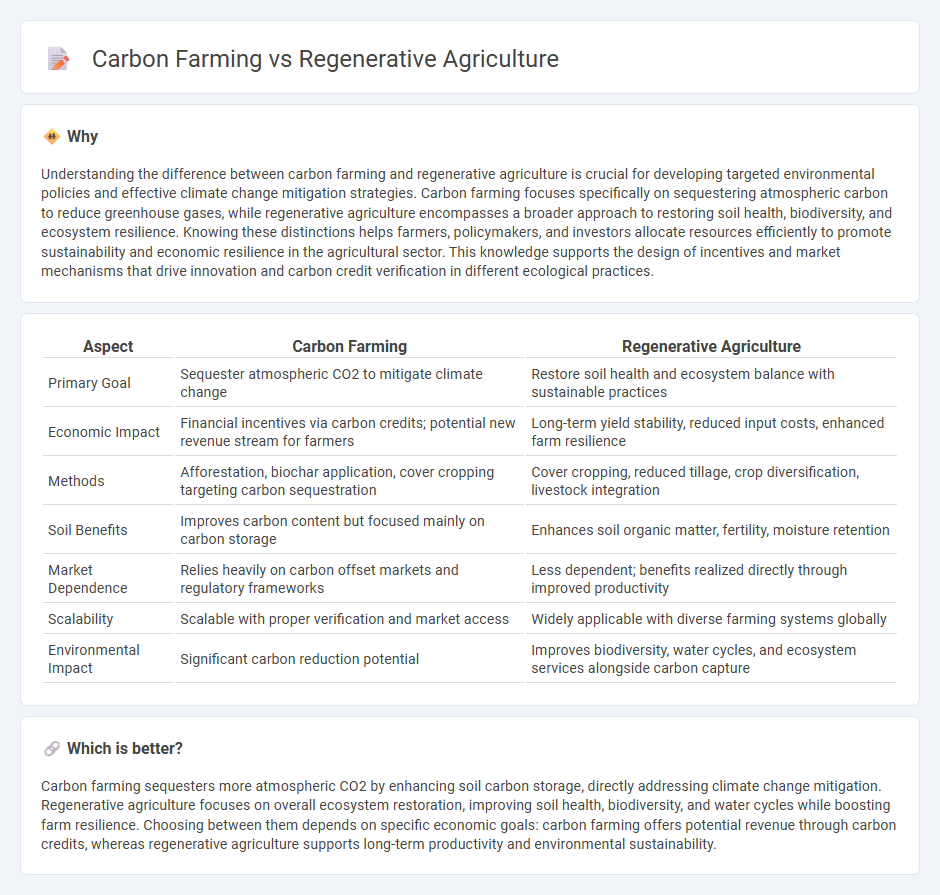
Carbon farming focuses on practices that increase carbon sequestration in soil and vegetation to combat climate change. Regenerative agriculture encompasses a broader set of techniques aimed at restoring soil health, enhancing biodiversity, and improving water cycles while also capturing carbon. Discover how these sustainable approaches can transform modern farming and contribute to a resilient economy.
Why it is important
Understanding the difference between carbon farming and regenerative agriculture is crucial for developing targeted environmental policies and effective climate change mitigation strategies. Carbon farming focuses specifically on sequestering atmospheric carbon to reduce greenhouse gases, while regenerative agriculture encompasses a broader approach to restoring soil health, biodiversity, and ecosystem resilience. Knowing these distinctions helps farmers, policymakers, and investors allocate resources efficiently to promote sustainability and economic resilience in the agricultural sector. This knowledge supports the design of incentives and market mechanisms that drive innovation and carbon credit verification in different ecological practices.
Comparison Table
| Aspect | Carbon Farming | Regenerative Agriculture |
|---|---|---|
| Primary Goal | Sequester atmospheric CO2 to mitigate climate change | Restore soil health and ecosystem balance with sustainable practices |
| Economic Impact | Financial incentives via carbon credits; potential new revenue stream for farmers | Long-term yield stability, reduced input costs, enhanced farm resilience |
| Methods | Afforestation, biochar application, cover cropping targeting carbon sequestration | Cover cropping, reduced tillage, crop diversification, livestock integration |
| Soil Benefits | Improves carbon content but focused mainly on carbon storage | Enhances soil organic matter, fertility, moisture retention |
| Market Dependence | Relies heavily on carbon offset markets and regulatory frameworks | Less dependent; benefits realized directly through improved productivity |
| Scalability | Scalable with proper verification and market access | Widely applicable with diverse farming systems globally |
| Environmental Impact | Significant carbon reduction potential | Improves biodiversity, water cycles, and ecosystem services alongside carbon capture |
Which is better?
Carbon farming sequesters more atmospheric CO2 by enhancing soil carbon storage, directly addressing climate change mitigation. Regenerative agriculture focuses on overall ecosystem restoration, improving soil health, biodiversity, and water cycles while boosting farm resilience. Choosing between them depends on specific economic goals: carbon farming offers potential revenue through carbon credits, whereas regenerative agriculture supports long-term productivity and environmental sustainability.
Connection
Carbon farming and regenerative agriculture intersect significantly by enhancing soil carbon sequestration and improving ecosystem health. Practices like cover cropping, reduced tillage, and agroforestry in regenerative agriculture increase organic matter in soils, which directly supports carbon farming goals to capture atmospheric carbon. These methods boost agricultural productivity while mitigating climate change impacts, aligning economic incentives with environmental sustainability.
Key Terms
Ecosystem Services
Regenerative agriculture enhances soil health, biodiversity, and water retention by using cover crops, crop rotations, and reduced tillage, supporting multiple ecosystem services. Carbon farming prioritizes carbon sequestration through practices such as agroforestry and biochar application, directly targeting greenhouse gas reduction. Explore more to understand how these approaches uniquely contribute to ecosystem restoration and climate mitigation.
Carbon Credits
Regenerative agriculture enhances soil health and biodiversity through practices like cover cropping and reduced tillage, which sequester carbon naturally and improve long-term farm resilience. Carbon farming specifically targets carbon sequestration by implementing precise techniques such as agroforestry and biochar application to generate verified carbon credits for trade in emission markets. Explore how these approaches differ in maximizing carbon credits and their impact on sustainable agriculture.
Value Chain Integration
Regenerative agriculture emphasizes restoring soil health and biodiversity by integrating crop, livestock, and agroforestry systems to create resilient ecosystems that enhance productivity and carbon sequestration. Carbon farming focuses specifically on practices such as biochar application, reforestation, and cover cropping aimed at maximizing carbon capture and storage throughout the agricultural value chain. Explore detailed insights on how value chain integration optimizes both approaches for sustainable environmental and economic benefits.
Source and External Links
What is regenerative agriculture? - Syngenta Group - Regenerative agriculture is an outcome-based food production system that restores soil health, protects the climate, and enhances biodiversity while improving productivity and profitability.
Regenerative agriculture - Wikipedia - Regenerative agriculture is a conservation approach to food and farming systems, focusing on soil regeneration, biodiversity, and ecosystem services to mitigate climate change.
Why Regenerative Agriculture? - Regeneration International - Regenerative agriculture involves practices that rebuild soil organic matter, reverse climate change, and restore biodiversity to ensure sustainable food systems and ecosystem health.
 dowidth.com
dowidth.com